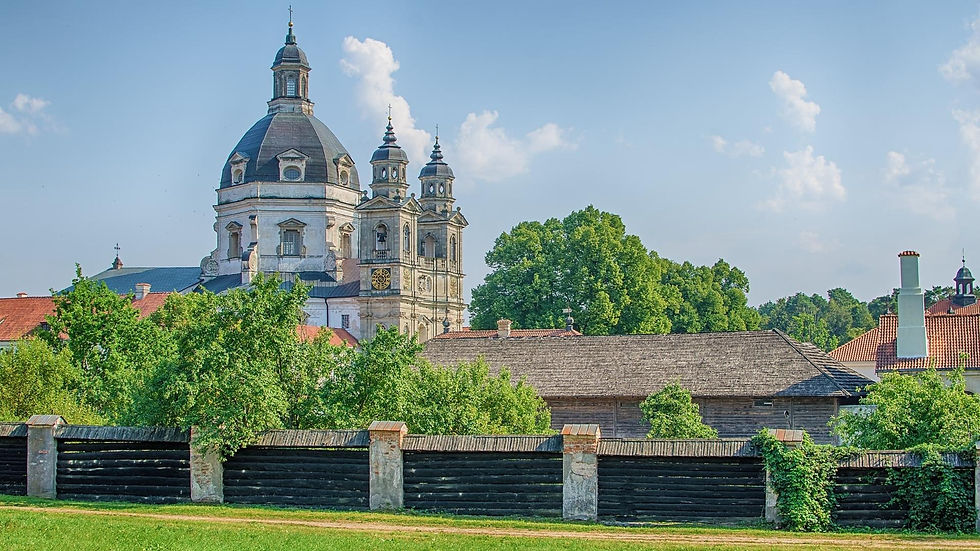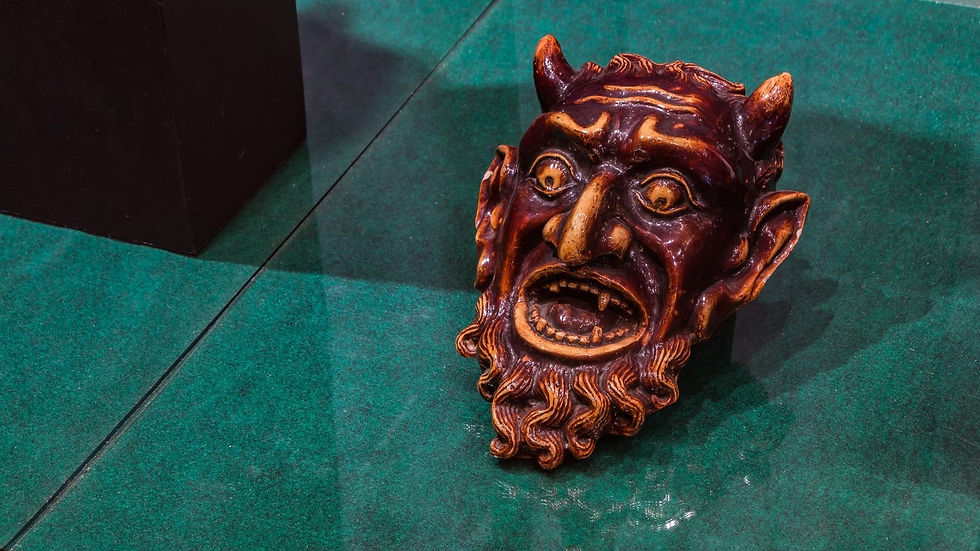BEST of Kaunas
- Lucie Plchotová
- Nov 2, 2022
- 7 min read
Updated: Jun 7, 2023
Unlike Vilnius, Kaunas is more or less in the center of Lithuania, so it should have the right to become the capital. That was the case during the interwar period. Despite being Lithuania's second-largest city, with 420,000 inhabitants, Kaunas has a much more provincial and sleepy feel than Vilnius. Nationally significant museums and galleries can be found in Kaunas. Kaunas is also significant for Lithuania because of its international airport, which is one of the largest in the Baltic region and was chosen by Ryanair as one of its bases.
Discover with us:
🎫 Events
What not to miss?
Vilnius Street
It is the most essential and beautiful street in the Old Town. It is the city's oldest street and was once part of the medieval road to Vilnius. Following reconstruction, it became entirely pedestrian and remained the old town's axis. Many of the structures along the road were made of wood. Later came the red-brick mansions of wealthy citizens, some of which still stand today. This street is home to many cozy restaurants, cafés, and souvenir shops, and many events and fairs occur here during the summer.
House of Perkunas
If you like Harry Potter, you should go to the House of Perkunas on Aleksoto. Of course, it wasn't used in the movies, but it reminded me of a Hogwarts building! The house is named after the Pagan God of Thunder, Perkunas. There is a legend surrounding the building's naming, which states that workers discovered a statue of Perkunas while demolishing a wall during renovations. After the brass statue fell from the wall to the ground, they decided to rename the building entirely. According to research, the Hanseatic League built this in the 15th century for commercial trade. The property was then sold to the Jesuits, and a chapel was built.
Historic Presidential Palace
When Poland annexed Vilnius during the interwar period, Kaunas became the country's temporary capital. As a result, this Russian imperial building in the Old Town was transformed into the President's official office. It remained that way until 1940 when Lithuania lost its independence, and the 'last meeting of the government was held here before the impending Soviet rule. The ownership was transferred to the Vytautas the Great War Museum in 1989. The palace now serves as an M. K. Čiurlionis National Art Museum branch. Outside the palace is a small garden with statues of the President during the interwar period and photographs of the city at the time. Another reason I liked this little courtyard was that they decorated all the trees with colorful lights in the winter. The palace and statues were also lit in rainbow colors, brightening a rainy winter night!
Pazaislis Monastery
The famous Pazaislis Monastery was founded in 1662 and is Lithuania's largest monastery complex. It is also one of the country's finest examples of Italian Baroque architecture. Krzysztof Zygmunt Pac, a Grand Duchy of Lithuania nobleman, originally built it as a Roman Catholic church for the Order of the Camaldolese Hermits. Later, in 1832, it was taken over by Russians and converted to an Orthodox Church. Following World War I, in 1920, the Lithuanian convent of St. Casimir sisters converted it back to a Roman Catholic temple. Pazaislis Monastery welcomes visitors all year and hosts the annual Pazaislis Music Festival, which lasts three months in the summer.
Kaunas Riverwalk
Kaunas is located at the meeting point of two rivers, the Nemunas and the Neris. Peaceful paths wind along the swiftly flowing water, making for a lovely evening stroll and another reason to visit Kaunas.
What else to visit?
Kaunas Old Town
The first thing you'll notice about Kaunas Old Town is how short most buildings are. The reason is that the town had a rule years ago that no building could have more than two floors! The area's cobblestone streets will take you directly to the Town Hall and Kaunas Castle. You'll pass adorable boutiques, inviting cafés, and restaurants along the way. Keep an eye out for interesting architecture. There are numerous historical styles and church spires. Some exciting statues tell a story (more on that below). You could get lost for hours!
Kaunas Town Hall
The Kaunas Town Hall is also a must-see for any visitor. The gleaming white structure stands out in the square and appears to be a church at first glance! The peachy-pink church in the back is the Church of Francis Xavier, which the Jesuits built in the 17th century. If you need a break, this is an excellent place to go because there are many cafés and restaurants in the area, albeit a little overpriced for the location.
Kaunas Castle
This medieval castle was built in the 14th century and is one of Lithuania's first brick castles. It was unique because it had two defense walls to keep the crusaders at bay. However, no one knows for sure who ordered the construction. It lost its status in 1408 when the city was granted Magdeburg rights, and the infrastructure was relocated to Town Hall Square. Kaunas castle was converted into a prison in the 16th century, and it is said that the souls of those prisoners still haunt the castle at night. So be cautious if you visit after dark!
Devil’s Museum
It is unique because it is the world's only Devil museum, with over 3,000 Satanic artifacts. Antanas Žmuidzinavičius (1876-1966), a well-known Lithuanian painter, professor, and public speaker is primarily responsible for the collections. His paintings and a workshop reconstruction are displayed as part of the museum. The museum has several floors and some interesting exhibits from all over the world. Learning about different countries' legends and superstitions about the devil was also fascinating. This museum also has a tradition where you can give them your devil! So, if you own a Devil statue, t-shirt, or trinket. Bring it over, and it might be on display.
M.K. Ciurlionis National Art Museum
The M. K. Ciurlionis National Museum of Art, founded in 1921, has grown to become one of Lithuania's oldest and largest art museums. It is the best place in Lithuania to learn about the evolution of Lithuanian and international art history and culture from antiquity to the present. The museum's primary mission today is to promote an understanding of cultural and artistic processes by collecting, preserving, studying, and presenting the M. K. Ciurlionis collection, as well as Lithuanian and global cultural heritage.
How to travel there?
Traveling by car to Kaunas from Riga, Warsaw, Vilnius, Klaipeda, and most other cities in the surrounding region is simple. Except on public holidays, parking in the central part of Kaunas is free from 8 a.m. to 6 p.m. Monday through Friday (no charge on weekends - except in the Town Hall Square, which is open from 8 a.m. to midnight).
The Kaunas bus station is one of the most modern in the region, not only because it looks great in pictures but also because it is open 24 hours a day, seven days a week, and has plenty of activities for those waiting for intercity (check the Lithuanian connections and purchase tickets online here) and international buses. Jazz concerts and movie screenings occur occasionally; consider yourself fortunate if you catch one! The bus station is not far from the city center; it takes less than 15 minutes to walk to Soboras, one of Kaunas' landmarks.
Rail links major cities in Lithuania, as well as Bialystok and Suwalki in Poland, to Kaunas. The ongoing Rail Baltica project will ensure fast and comfortable connections between Kaunas and Riga, Tallinn, and Warsaw in the future.
Wizz Air, Ryanair, LOT, and charter flight companies serve Kaunas International Airport. It is in the country's center, 14 kilometers northeast of Kaunas and 100 kilometers west of the capital, Vilnius. To get to the city center for the lowest price, take the city bus #29G (its timetable is adjusted to the arrivals schedule).
When to travel there?
May, June, July, August, and September are the best months for good weather in Kaunas. June, July, and August are the warmest months on average. The month of January is the coldest of the year. May, June, July, and August are the wettest months.
Average costs
What amount of money will you require for your trip to Kaunas? You should budget around €76 per day for your vacation in Kaunas, which is the average daily price based on other visitors' expenses. Previous visitors spent an average of €30 on meals for one day and €13 on local transportation. In addition, the average hotel room rate in Kaunas for a couple is €71. So, a one-week trip to Kaunas for two people costs an average €1,069. All of these average travel prices were gathered from other travelers to assist you in planning your own travel budget.
Where to eat?
It's difficult to say which restaurant is the best in Kaunas because it's a matter of taste, both literally and metaphorically. To get you started, here are a few of our favorite (if somewhat subjective) dining options in Kaunas.
Dia, a favorite of Kaunas' sophisticated elite, is a top Kaunas restaurant that would look like home in any city.
Etno Dvaras serves what is arguably the best Lithuanian food in Kaunas. When the weather permits, reserve an outside table in a prime Old Town location.
Moksha offers an intimate setting for some of the Baltics' best and most authentic Indian cuisine. The menu is limited for a reason. You will not be let down.
Tuk Tuk Indija is a fine shop with the added bonus of a small counter serving fresh Indian cuisine inside if the idea of a great Indian takeaway appeals to you. Picnicking has never tasted so good as it does here, just a few hundred meters from the river.
Events
MAMA music awards
A jury selects the best Lithuanian musicians and singers from various genres. In what aims to be the premier annual event of Lithuanian music, the gala format is combined with a public concert that easily sells out Kaunas arena. This event is in early January.
Independence day parade
A massive grassroots parade in downtown Kaunas with flags and patriotic chants. The Independence day parade is celebrated on the 16th of February every year.
Kaunas Jazz
The festival, founded in 1990 in collaboration with independent Lithuania, brings together local and international jazz musicians (20 bands per year). Some concerts are free, and some are even held in the streets. The Kaunas Jazz festival is celebrated at the end of April and the beginning of May.
Hansa days
Near the Kaunas castle, medieval arts and crafts are recreated (along with modern shopping opportunities). It is usually celebrated during the weekend in mid-May.
We've reached the end of the article about Kaunas. This city has an amazing atmosphere and we believe you will love it as much as we did! In the meantime, you can read other articles on our blog. How about Vilnius, Utrecht, or Copenhagen? Do not forget to follow us @thewalkingparrot to be always updated on the new releases. We will be back soon with a new article!













Comments